Innovative Ways to Use Wooden Maps in Storytelling
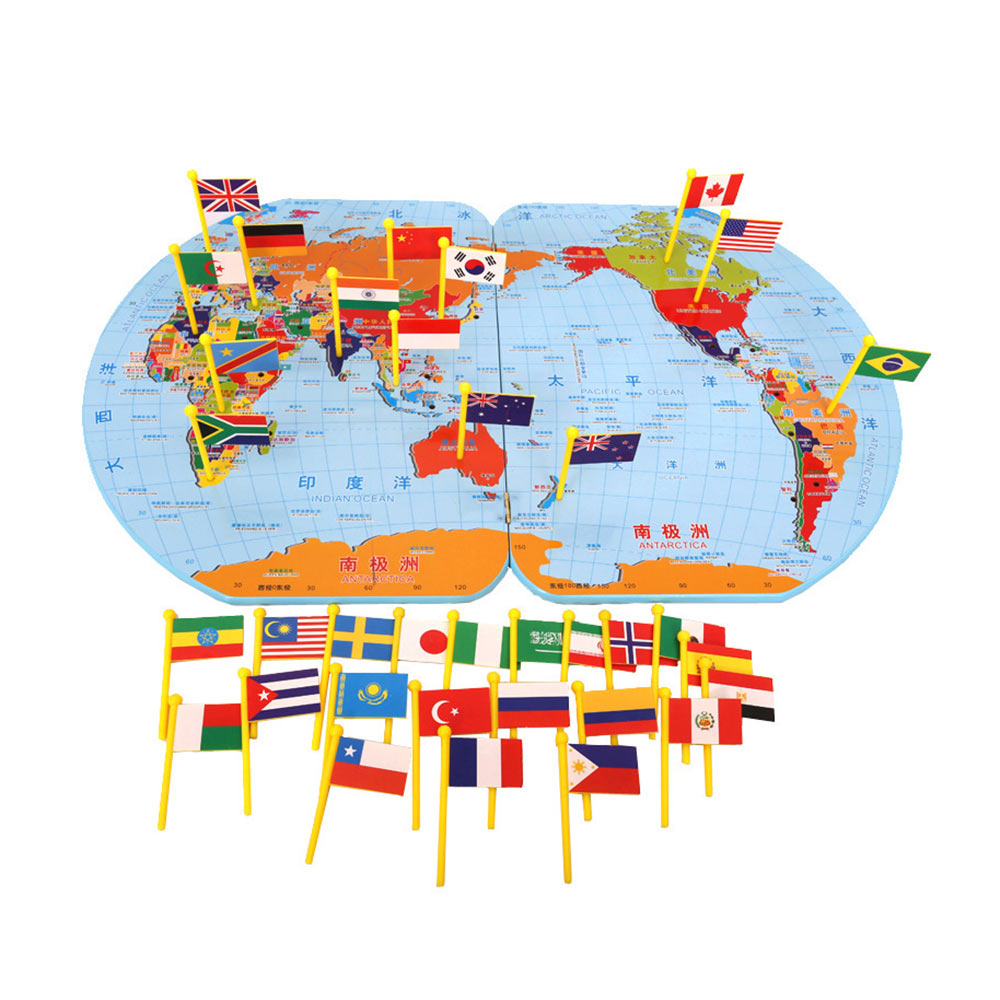
A wooden map is more than just a decorative piece; it’s a versatile storytelling tool that can vividly bring narratives to life. Whether you’re a travel enthusiast, an educator, or someone who loves to craft meaningful personal stories, incorporating a wooden map into your storytelling arsenal opens up new creative horizons. Its tactile nature, aesthetic charm, and customizable potential turn simple tales into immersive experiences, engaging audiences both visually and emotionally.
In this article, we’ll explore numerous innovative ways to use wooden maps in storytelling. From personal travel chronicles to educational journeys and interactive art installations, discover how this beautiful wooden art piece can transform the way stories are told and remembered.
1. Personal Travel Chronicles: Turning Journeys into Visual Narratives
Travel stories are among the most compelling narratives because they evoke a sense of adventure, discovery, and personal growth. Using a wooden map as a visual aid adds depth and tangibility to these tales, allowing storytellers to map out their journeys dynamically. This method not only preserves memories but also creates engaging displays that invite viewers to connect authentically.
A. Creating a Travel Timeline
Transform your travel experiences into an interactive timeline on a wooden map by using small pins, flags, or labels to mark visited destinations. Each pin can be accompanied by a photo, a brief story, or a souvenir attached nearby, creating a layered storytelling piece.
Imagine sitting down with friends or family, walking them through your adventures, and physically pointing to different locations. This tangible experience makes the storytelling more immersive and memorable. It also encourages others to share their stories, fostering a collective exchange of travel anecdotes.
B. Highlighting Cultural Encounters
A wooden map can serve as a backdrop for illustrating cultural encounters and significant moments during your travels. For example, you might focus on a particular country or city where you had a transformative experience—perhaps a language barrier that you overcame or a local festival that opened your eyes to new traditions.
Incorporate small artifacts, drawings, or notes directly onto the map or nearby, enriching your narrative visually. This layered approach turns a simple map into a storytelling canvas that emphasizes personal growth, challenges, and the diversity of human experience.
C. Creating a “Next Destination” Planning Tool
Beyond recounting past journeys, a wooden map can be an interactive planning tool for future adventures. Use it to visualize travel goals, connect ideas, and strategize routes. For example, each upcoming destination can be marked with a pushpin or sticker, and the map can include notes about what excites you about each place.
This method makes the process of storytelling and planning both creative and motivational. It allows travelers to see their aspirations clearly, creating a dynamic narrative that evolves with their experiences.
2. Educational Stories: Using Wooden Maps to Enhance Learning

Educational environments thrive on visual aids and hands-on learning tools. A wooden map provides a tactile, engaging way to teach geography, history, and cultural awareness. Incorporating storytelling into educational activities not only makes learning more effective but also more memorable.
A. Visualizing Historical Events
Historians and educators can use a beautifully crafted wooden map to narrate historical events. For instance, during lessons about migration, exploration, or war, the map acts as a visual anchor.
Consider illustrating the routes of explorers like Columbus or Magellan. Mark their paths with named pins or lines, and add contextual stories about their journeys. The tactile nature of the wooden map helps students visualize complex movements and connections, facilitating a deeper understanding.
B. Cultural and Geographical Stories
Geography lessons often involve memorizing countries and capitals, which can become monotonous. By integrating storytelling, educators can create narratives around regions—such as the history of indigenous peoples or the rise and fall of empires—that resonate emotionally.
Using a wooden map, teachers can assign each student a region and have them research and tell a story about it. The students then present their findings by highlighting the area on the map with pins, flags, or mini-objects. This approach transforms facts into stories that stick.
C. Interactive Historical Reenactments
Storytelling is especially powerful when combined with reenactments. Use the wooden map as a setting for reenacting historical events. Students or participants can use small items or drawings as props, aligning them with locations on the map.
For example, a reenactment of the Silk Road trade routes can involve actors or students ‘moving’ along the map with cloth scrolls, exchanging stories about the cultural exchanges that occurred along the route. Such immersive activities foster a nuanced understanding of history and geography.
3. Personal and Family Stories: Crafting Heritage Narratives
Everyone has a story that ties them to their roots. Using a wooden map, you can craft a visual heritage story, connecting family history with geographic origins. This approach not only preserves memories but also shares them in a captivating, engaging way.
A. Building a Family Tree with Geographical Roots
Create a family heritage map by marking ancestral origins with pins or symbols. Each mark can include birthplaces, ancestral villages, or significant family events, accompanied by stories, photos, or heirlooms.
This visual layout helps younger generations understand their roots and fosters a sense of identity. It turns abstract lineage data into a storytelling tapestry, connecting personal histories with geographic realities.
B. Sharing Family Travel and Life Stories
Family vacations, migration stories, or significant relocations can be depicted on a wooden map. For instance, if your family moved from one country to another, use a map to illustrate this journey, adding stories about what prompted each move and notable memories.
Such visual storytelling can become a treasured family keepsake. It sparks conversations across generations and helps preserve stories that might otherwise be forgotten.
C. Celebrating Cultural Heritage
Use the wooden map during family gatherings or cultural celebrations to tell stories about your ancestors’ origins and traditions. Incorporate cultural symbols, food memories, or language snippets into the display.
This approach reinforces cultural identity and educates younger family members about their heritage, turning a simple map into a living narrative of identity and history.
4. Artistic and Creative Storytelling Projects
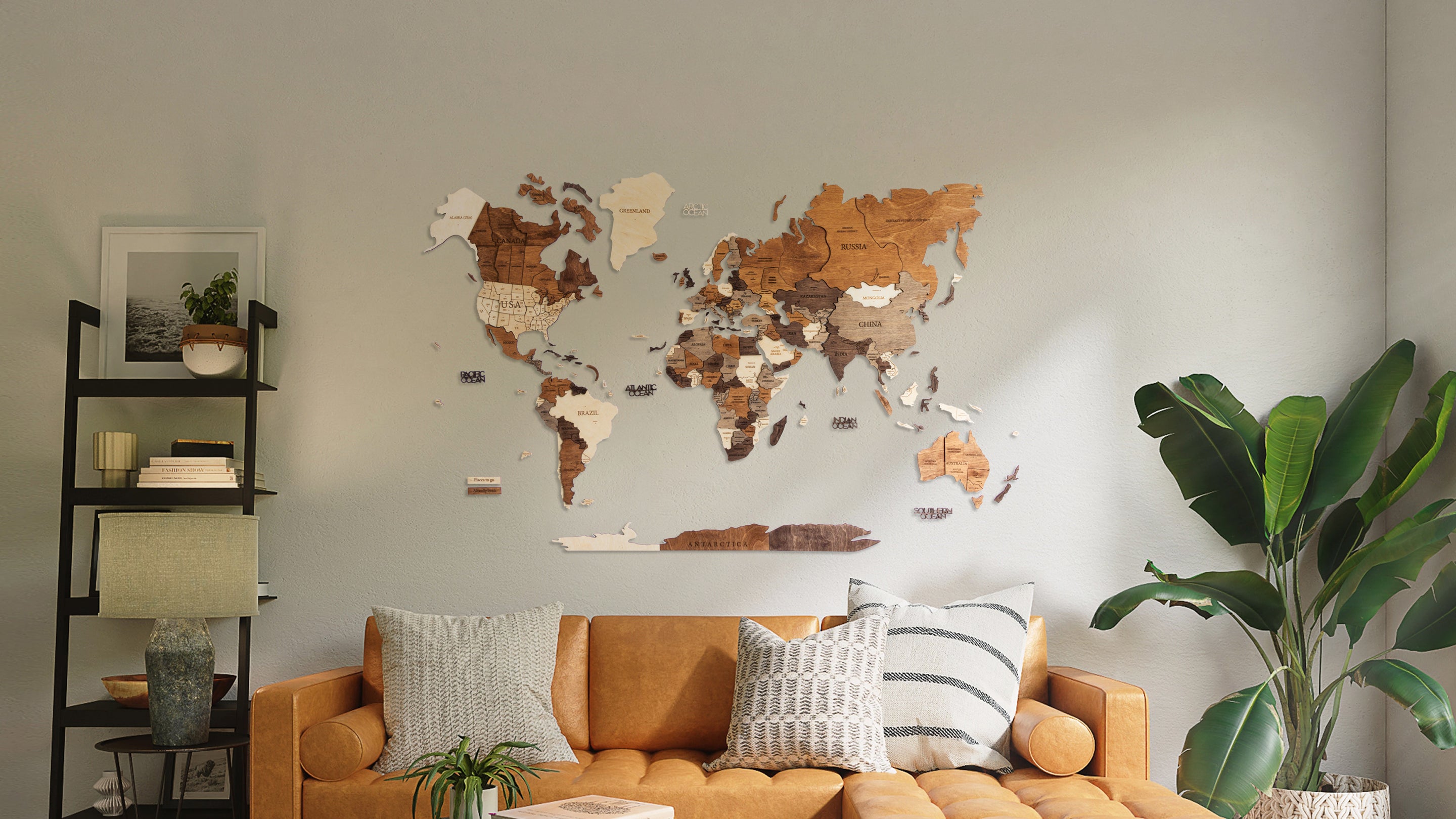
A wooden map serves as a versatile canvas for artistic expressions that tell stories visually. Artists and storytellers can leverage this medium to craft narratives that combine visual art, sculpture, and storytelling techniques for profound emotional impact.
A. Creating a Map-Based Storytelling Installation
Transform a wooden map into an immersive storytelling installation. Use layered textures, light, sound, and interactive elements—such as moving parts or hidden compartments—to tell a story dynamically.
Imagine a map depicting a journey of a mythical hero: the map itself could be a three-dimensional terrain, with moving figurines representing characters and sound effects elucidating key moments. This blends storytelling with multimedia art, captivating audiences on multiple sensory levels.
B. Narrative Art Projects Using Map Components
Incorporate different map elements—like engraved text, miniature figures, or mixed media—to narrate stories of personal growth, cultural exchange, or environmental changes.
For example, an artist may carve stories into the wood of the map’s landmasses or embed small objects that symbolize different chapters in a story. This creates an engaging, tactile experience that keeps viewers exploring and interpreting the narrative layers.
C. Storytelling in Public Art and Community Projects
Public art projects using wooden maps can illustrate community histories, local legends, or collective memories. These projects foster a sense of shared identity and serve as storytelling landmarks.
Communities could contribute their stories via small objects or written anecdotes attached to the map, creating an evolving narrative space that reflects diverse perspectives and histories.
5. Innovative Interactive Storytelling: Combining Maps with Technology

The integration of traditional wooden maps with digital technology opens up new possibilities for storytelling that are engaging and highly interactive. Augmented reality (AR), QR codes, and multimedia presentations can breathe life into static maps.
A. Using QR codes for Extended Narratives
Embed QR codes on the map that link to videos, audio recordings, or detailed stories. This allows viewers to explore stories in depth by simply scanning the codes with their smartphones.
For instance, a wooden map of the United States could have QR codes next to each state, linking to stories about the state’s history, cultural highlights, or personal memories. This turns a simple wall decor into an interactive storytelling experience.
B. Augmented Reality (AR) Storytelling
AR apps can overlay digital imagery onto a physical wooden map. When viewed through a smartphone or AR glasses, the map could animate, show movement along routes, or display contextual information about specific locations.
Imagine visiting a museum exhibit featuring a wooden world map. As you point your device at different countries, the AR technology could show historical events, influential figures, and cultural stories, creating an immersive educational tool.
C. Interactive Story Maps for Community Engagement
Communities can use digital story maps that complement physical maps to share collective stories. These platforms allow residents to add their narratives, photos, and videos, creating a living story that evolves over time.
This approach fosters community pride and keeps storytelling dynamic and inclusive, blending the tactile beauty of a wooden map with the expansiveness of digital storytelling.
6. Conclusion
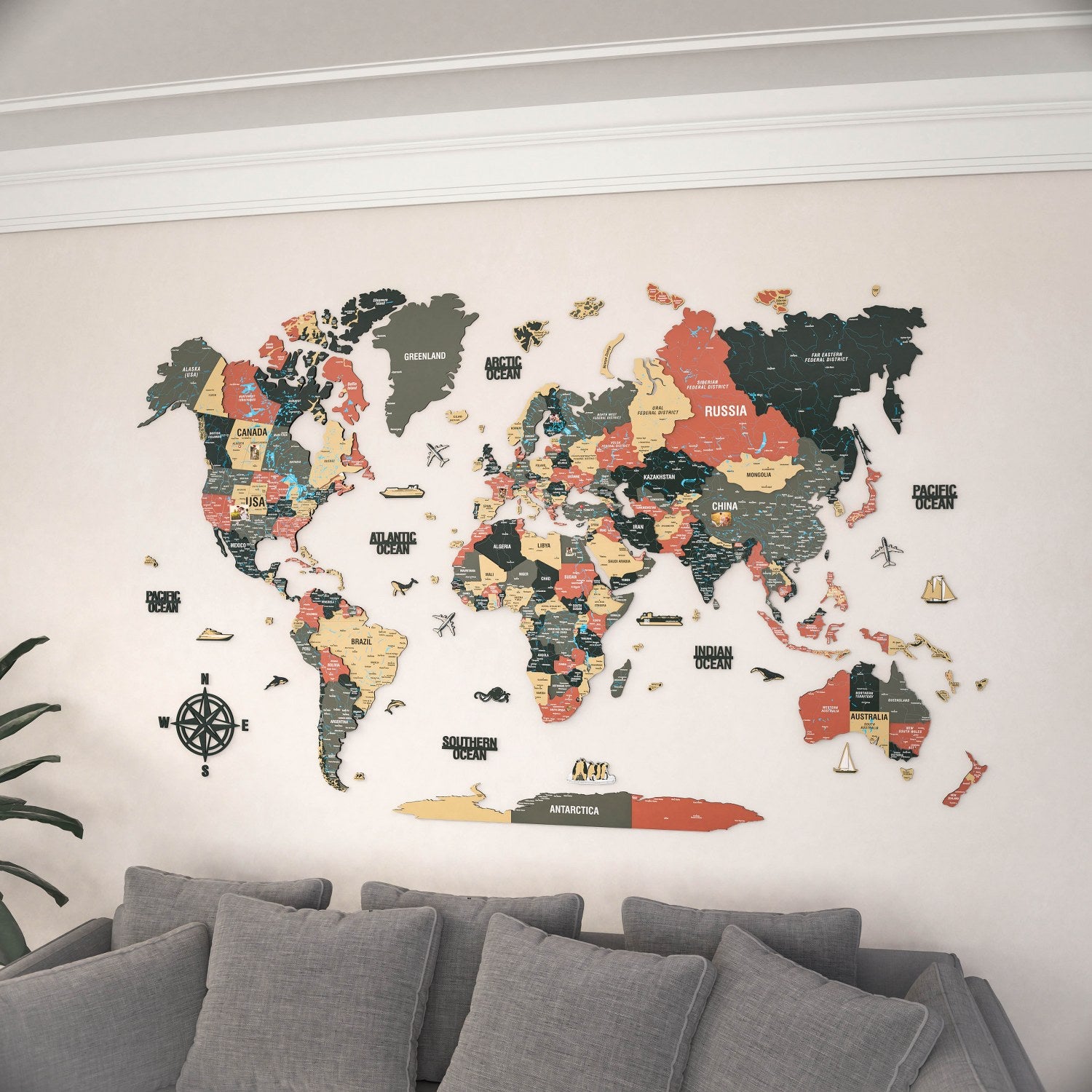
A wooden map is much more than a decorative artifact; it’s a powerful storytelling tool capable of transforming narratives into vivid, engaging experiences. Its versatility allows for personal, educational, artistic, and interactive storytelling methods, making stories more tangible and emotionally resonant.
From turning travel memories into visual journeys, enriching classroom lessons with cultural narratives, to creating community art projects, the wooden map bridges the gap between image, story, and emotion. Its tactile and aesthetic appeal invites storytellers to craft stories in innovative ways, ensuring that stories not only resonate but also endure.
Harness the potential of the wooden map to elevate your storytelling, and watch how this elegant piece becomes a centerpiece of connection, memory, and imagination.
7. References

- Wooden world maps – for visual inspiration and ideas on interactive travel storytelling.
- Additional resources on visual storytelling techniques and interactive art.
A wooden map serves not only as a decorative piece but also as a unique canvas for artistic expressions that encapsulate narratives, emotions, and experiences. Artists and storytellers can harness this raw and rustic medium to illustrate stories that engage viewers at a profound level, merging visual art with storytelling techniques. In this section, we will explore innovative ways to use wooden maps as platforms for artistic and creative storytelling projects.
Creating a Map-Based Storytelling Installation
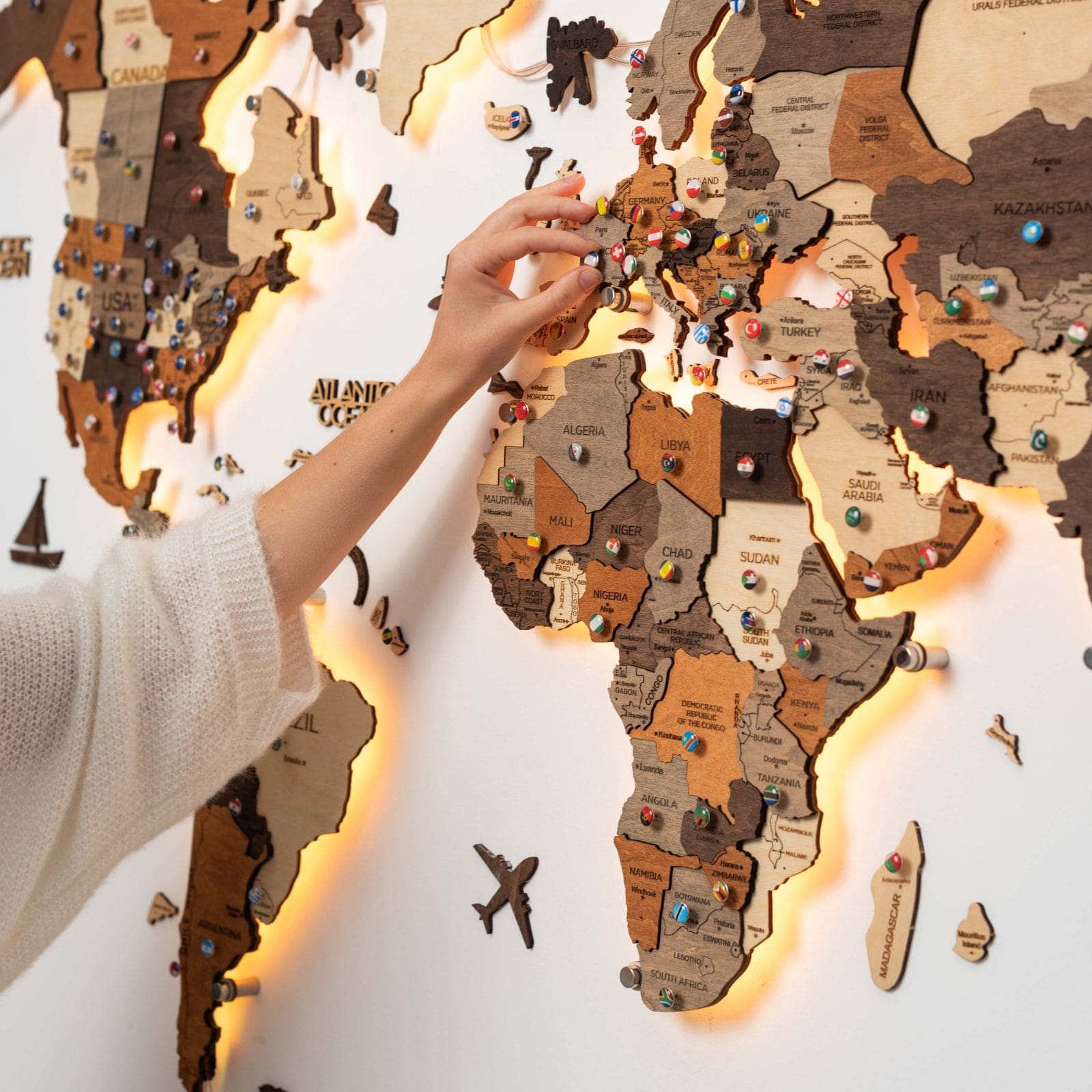
Transforming a wooden map into an immersive storytelling installation offers a fresh perspective on narrative engagement. This approach involves layers of artistic expression, intertwining various elements like textures, lights, sounds, and interactive mechanisms to bring the story alive.
The Concept of Immersive Art
The essence of immersive art lies in engaging multiple senses to create a captivating experience for the audience. Consider a storytelling installation that narrates the journey of a legendary hero through a wooden map. By using a three-dimensional terrain crafted from wood, artists can sculpt mountains, rivers, and valleys that precisely outline the hero’s journey.
The incorporation of interactive elements, such as moving parts that denote significant events or characters, infuses dynamism into the experience. For instance, imagine a river flowing through the map that lights up as viewers press buttons corresponding to different narrative sequences, emphasizing the significance of each phase of the journey.
Multi-sensory Storytelling Elements
To enhance the immersive experience, sound plays an undeniable role. Imagine adding carefully curated audio elements that capture the essence of the story: the sound of wind rustling through trees as the hero traverses forests, or the echoes of a bustling marketplace in a city.
The combination of these sensory elements ensures that viewers not only engage with the map visually but also emotionally. Artists can weave the story through sensory experiences, allowing each visitor to inhabit the narrative and connect with it on a personal level.
The Role of Audience Interaction
Audience interaction in storytelling installations fosters an environment of exploration and individual interpretation. By inviting viewers to move through the space, touch various components, or even contribute their stories, the installation becomes a collaborative narrative shaped by shared experiences.
In this dynamic environment, a wooden map transcends its physicality, evolving into a living organism of stories, memories, and engagement that resonates deeply with those who encounter it.
Narrative Art Projects Using Map Components
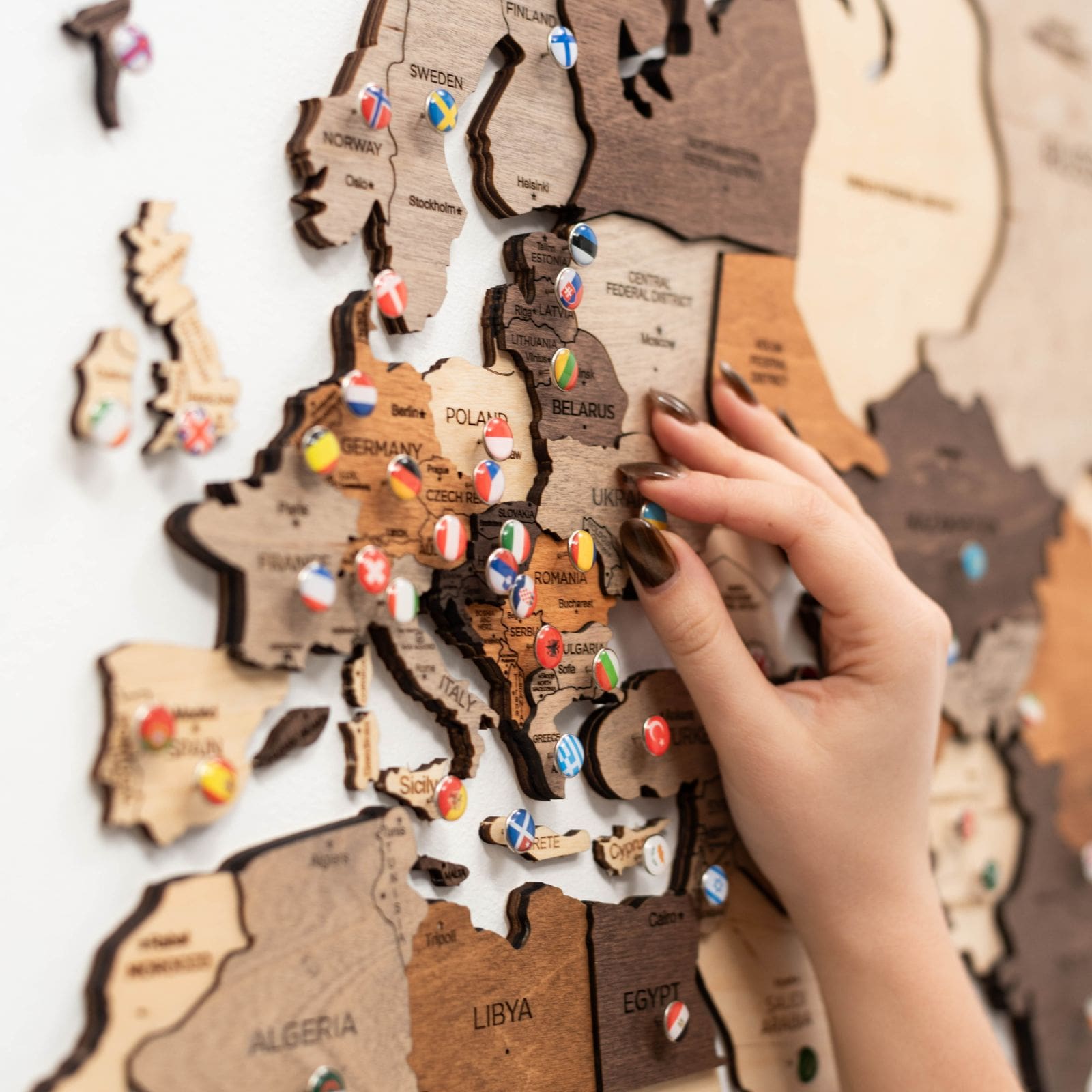
Artistic storytelling using wooden maps can exploit various physical attributes and textures to recount intricate stories. By weaving together visual artistry and narrative, these projects aim to create a multi-layered engagement that evokes curiosity and contemplation.
Textual and Symbolic Representation
Narrative art projects can employ engraved text and symbolic objects to evoke deeper meanings associated with themes like personal growth and cultural exchange. For example, artists can carve personal anecdote snippets into the wood’s surface, allowing visitors to read and reflect on different journeys represented within the map.
Particularly powerful are the placement and choice of symbols. Miniature figures representing crucial family members, ancestral artifacts, or culturally significant items can be embedded into the landscape of the map. Each element serves as a story anchor, prompting viewers to ponder its significance and relevance to the overarching theme.
Mixed Media Approaches
Delving deeper into creativity, artists can leverage mixed media techniques to add vividness to the narratives conveyed by wooden maps. Integrating materials such as beads, fabrics, metals, or even digital screens creates enriched narratives that elevate the storytelling experience.
Consider the use of vibrant threads weaving through the wood to indicate pathways and journeys across generations, juxtaposed with photographs or digital images tucked into hidden compartments. This makes for a tactile, engaging experience that invites viewers to touch, explore, and discover layers of tales embedded within the wooden landscape.
Encouraging Viewer Interpretation
One of the most engaging aspects of narrative art is the invitation to audience interpretation. Personal experiences and emotions can influence how viewers understand and relate to the stories shared through a wooden map.
Artists can curate these experiences by providing questions, prompts, or activities that encourage a dialogue around the stories exhibited. For instance, visitors could be encouraged to share their interpretations or contributions related to the narrative. This collaborative aspect enriches the collective understanding, transforming the map into a tapestry of interconnected histories.
Storytelling in Public Art and Community Projects

The allure of a wooden map shines through when it is used as a centerpiece for public art projects, fostering storytelling within communities. These initiatives not only embellish public spaces but also encapsulate local histories and collective memories.
Celebrating Community Heritage
Public art projects that utilize wooden maps serve to celebrate a community’s heritage. A map can represent local landmarks, historical events, or significant cultural practices while inviting community members to contribute their stories, enriching the narrative tapestry.
A community may join hands to produce a large-scale wooden map, with each neighborhood represented distinctly. Storytelling stations could surround the map, where residents can share personal anecdotes or history related to that specific area, which are then carved or inscribed into the backdrop.
Collaborative Storytelling Initiatives
Collaborative projects encourage widespread participation and diversity in storytelling by gathering stories from various community members. The wooden map acts as a repository for these tales, evolving into a multi-faceted narrative that highlights different cultural perspectives.
For instance, a community could hold workshops where residents create individual artwork or written contributions reflecting their experiences, which are then attached to the map. The map thus becomes a living entity, continuously growing and adapting to incorporate ongoing narratives and changes within the community.
A Living Testimony to Shared Identity
Ultimately, public art projects featuring wooden maps can act as lasting testaments to shared identity and cohesion amongst community members. When individuals see their stories represented and honored, it reinforces their connection to a broader narrative that transcends individual experiences, thus nurturing unity.
By weaving personal histories into a communal framework, the wooden map becomes a bridge for dialogue across ages, allowing younger generations to embrace the past while staying rooted in their communities’ stories and values.
Conclusion
A wooden map is much more than a decorative artifact; it’s a powerful storytelling tool capable of transforming narratives into vivid, engaging experiences. Its versatility allows for personal, educational, artistic, and interactive storytelling methods, making stories more tangible and emotionally resonant.
From turning travel memories into visual journeys to enriching classroom lessons with cultural narratives—wooden maps bridge the gap between image, story, and emotion. Their tactile and aesthetic appeal invites storytellers to craft innovative and memorable experiences, ensuring that stories not only resonate but also endure.
Harness the potential of the wooden map to elevate your storytelling, and witness how this elegant piece becomes a centerpiece of connection, memory, and imagination, fostering bonds that span generations and celebrate the richness of human experience.
References
- Wooden world maps – for visual inspiration and ideas on interactive travel storytelling.
- Additional resources on visual storytelling techniques and interactive art.
